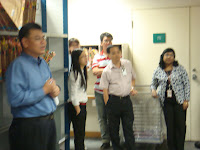 FLU
FLU - a little word with such a strong impact when left unchecked. We have recently been taken back to those dark days in 2003, when the SARS virus struck so many of us and affected our lives in so many ways, some of which never to be to the same as they were before.
We knew some of those who had succumbed to it. We have worked alongside them here in Tan Tock Seng Hospital. We were in the thick-and-thin of it all, from the battles within the hospital to the battles against the public, who had shunned us for the simple reason that we were employees of THE hospital, where all the action took place.

Listening to the recent reports of the
Swine Flu outbreak brings back floods of memories and I feel this is the right time to bring across some simple messages and practices that will go a long way to protecting ourselves and our loved ones.
For those who were here when SARS took us by surprise, we know the importance of protection. For those who have joined us after SARS, it is hope that the importance of such practices and safeguards are not lost on them. They are the only protection we have.
No one can promise you that you will never get hit with another cold or suffer another bout of flu, but you can increase your odds of staying well with some simple strategies.

While contracting a simple cold will not kill you, they can weaken your immune system to the extent that it allows other more serious germs into your body. Consider the number of times your cold has turned into bronchitis or a sinus infection. On average, an adult suffers two colds a year. Now think, that's a lot of opportunities for some serious illness, don't you think?
Here are some tips which may go along way to help you keep flu at bay.
1.
Wash Your Hands and wash them as often as possible. This can cut down respiratory illnesses by up to 50 percent.

2.
Dry Your Hands In Public Toilets because a shockingly large percentage of people fail to wash their hands after using them. And guess what? Every single one of them touches the door handle on the way out. So, please use a paper towel to turn off the tap. Use another paper towel to dry your hands, and, another to open the door.

3.
Get A Flu Shot Every Year. It is the best prevention strategy for influenza. This is particularly important for people at risk of serious complications that may result from flu. This includes you and I, those in the healthcare settings, those with chronic conditions such as diabetes, asthma, kidney problems or heart disease, people aged 65 and above and pregnant women. People whose immune system is considerably weakened should also consult with their doctors about getting the flu shot.
4.
Carry Hand Sanitiser With You. Colds are typically passed not from coughing or kissing, although these are two modes of transmission, but from hand-to-hand or hand-to-object contact, since most cold viruses can live for hours on objects. You then put your hand in or near your mouth or nose, and voila! You're sick! Carry hand sanitiser with you so that you can clean your hands anytime.

5.
Change Your Toothbrush Every Three Months because your toothbrush can be a breeding ground for germs. It is a good idea to replace it after you've had a cold or flu to prevent re-infection.

6.
Put A Box Of Tissue Wherever People Sit so that when anyone who has to cough or sneeze or blow his nose will do so in a manner that will least likely spread germs. Do not let aesthetics thwart you.
7.
Use Your Knuckles To Rub Your Eyes as they are less likely to be contaminated with viruses than your fingertips. This is particularly important given the fact that an average person rubs his eyes between 20 to 50 times a day.
8.
Sneeze And Cough Into Your Arm Or Tissue. Whoever told us to cover our mouths when we cough or sneeze got it wrong. That just puts the germs right on our hands, where you can spread them to objects and other people. Cough and sneeze into your elbow if a tissue is not handy.

9.
At First Hint Of A Cold, launch yourself into the following preventive blitz:
a. Suck on a zinc gluconate lozenge until it melts away and continue to suck on one every few hours.
b. Cook up a pot of chicken soup.
c. Roast garlic in the oven, drizzling some olive oil over the whole coves and wrapping it with baking foil.
It is everybody's responsibility to take care of one another. Let us be pro-active in this aspect of flu prevention and arm ourselves with these simple protective measures. What's more - it may just win you the Subaru Impreza - as part of the hospital drive to promote hand hygiene.

 We have just completed our emergency roll call to particularly update the department on the situation connected to the Swine Flu pandemic.
We have just completed our emergency roll call to particularly update the department on the situation connected to the Swine Flu pandemic. nominate helpers to cater to this need. HIS Manager Christopher Teo has nominated everyone in the department to assist should the need arises.
nominate helpers to cater to this need. HIS Manager Christopher Teo has nominated everyone in the department to assist should the need arises. 
 TTSH CEO Dr Lim Suet Wun will be conducting a series of townhall talks the whole of tomorrow and all staff are to attend one of the sessions. The townhall talk is targeted at addressing the Swine Flu Epidemic hitting the shores of Mexico and America.
TTSH CEO Dr Lim Suet Wun will be conducting a series of townhall talks the whole of tomorrow and all staff are to attend one of the sessions. The townhall talk is targeted at addressing the Swine Flu Epidemic hitting the shores of Mexico and America.


















































